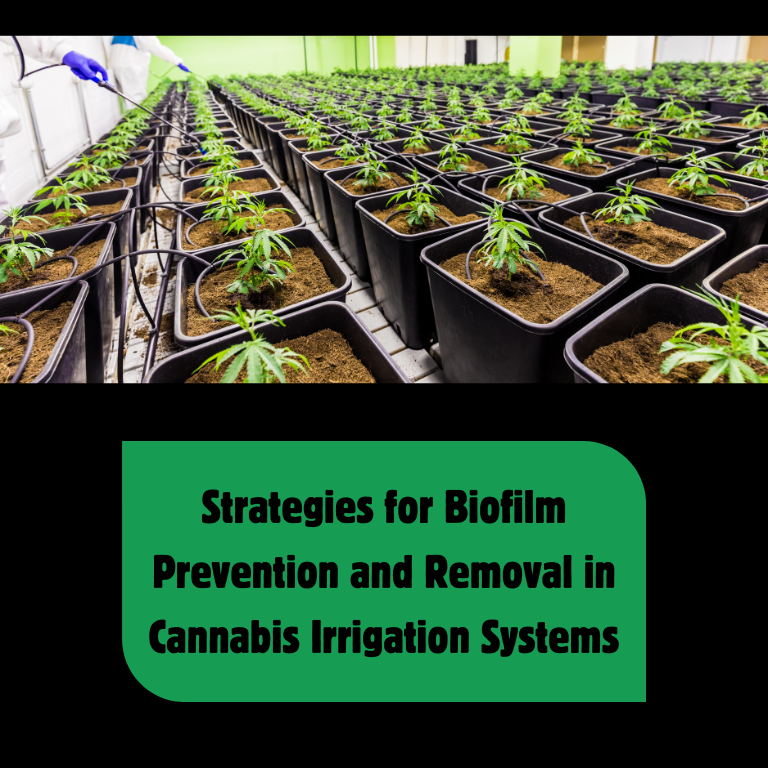Optimizing Cannabis Irrigation: Preventing and Removing Biofilm

In the world of cannabis cultivation, ensuring the delivery of clean, uncontaminated water to your plants is paramount. Biofilm, a complex aggregation of microorganisms adhering to surfaces in moist environments, poses a significant threat to the efficiency and hygiene of irrigation systems. Understanding and addressing biofilm formation is crucial for maintaining optimal growth conditions and plant health.
What is Biofilm?
Biofilm is a resilient, slimy layer formed by communities of bacteria, fungi, and other microorganisms. These organisms produce extracellular polymeric substances (EPS) that help them adhere to surfaces and protect them from environmental stresses. Biofilms can form on virtually any surface exposed to water, including the interior surfaces of irrigation pipes and tanks.
Biofilm in Cannabis Irrigation Systems
In cannabis irrigation systems, biofilm can quickly develop due to the constant presence of water and nutrients. This biofilm can harbor pathogenic microorganisms, clog irrigation lines, and significantly reduce water flow, ultimately impacting the health and yield of cannabis plants.
Challenges Posed by Biofilm
Biofilms present several challenges:
- Clogged Irrigation Lines: Biofilms can accumulate and block water flow, leading to uneven watering and potential plant stress.
- Reduced Water Flow: Even partial blockages can reduce the efficiency of irrigation systems.
- Contamination Risks: Biofilms can harbor harmful pathogens that may infect cannabis plants.
Identifying Biofilm in Irrigation Systems
Detecting biofilm early is critical. Look for signs such as reduced water pressure, visible slimy residues, or discolored water. Regular inspection and monitoring can help identify biofilm presence before it becomes a significant problem.
Biofilm Prevention Strategies
Preventing biofilm formation is more effective than dealing with established biofilms. Key strategies include:
- Regular System Maintenance: Routine cleaning and maintenance can prevent biofilm buildup.
- Water Quality Monitoring: Ensure water used is of high quality, with low microbial counts.
Mechanical Cleaning Methods
Mechanical cleaning involves physically removing biofilms through:
- Flushing: High-pressure water can dislodge biofilm from surfaces.
- Scrubbing: Manual or automated scrubbing can effectively remove biofilm from accessible surfaces.
Chemical Treatment Options
Chemical treatments are often used to dissolve biofilms:
- Chlorine: Commonly used, but can be harmful in high concentrations.
- Hydrogen Peroxide: Effective and breaks down into water and oxygen.
- Peracetic Acid: Strong oxidizing agent that can be used in low concentrations.
Biological Control Methods
Biological treatments use beneficial organisms to outcompete harmful biofilms:
- Beneficial Bacteria: Certain bacteria can prevent harmful biofilm formation.
- Enzymatic Treatments: Enzymes can degrade the EPS matrix of biofilms.
Use of UV and Ozone Treatments
UV and ozone are effective at controlling biofilm:
- UV Light: Destroys microorganisms and disrupts biofilm formation.
- Ozone: Strong oxidant that can kill biofilm-forming microorganisms.
Filtration Systems
Filtration helps remove particulates that contribute to biofilm formation:
- Sand Filters: Effective at removing suspended solids.
- Activated Carbon Filters: Remove organic compounds that can fuel biofilm growth.
Maintaining Optimal Water Quality
Ensuring optimal water quality involves:
- Water Source: Use clean, treated water to minimize contaminants.
- pH Levels: Maintain a balanced pH to prevent conditions that favor biofilm growth.
- Nutrient Balance: Avoid excess nutrients that can promote biofilm formation.
Design Considerations for Irrigation Systems
Designing systems to prevent biofilm includes:
- Materials: Use materials resistant to biofilm formation.
- Layout: Avoid dead zones where water can stagnate.
Regular Inspection and Monitoring
Implement a schedule for regular inspection and monitoring:
- Schedule: Inspect systems weekly or bi-weekly.
- Tools: Use cameras and sensors to detect biofilm.
- Record-Keeping: Maintain logs of inspections and maintenance activities.
Integrating Multiple Prevention Methods
Combining different strategies can be more effective:
- Mechanical, Chemical, and Biological Methods: Use in tandem for comprehensive biofilm control.
Cost-Benefit Analysis of Prevention and Removal
Evaluate the economic impact:
- Initial Costs vs. Long-Term Savings: Investing in prevention can save money on costly repairs and crop losses..
Future Trends in Biofilm Management
Emerging technologies and research are shaping the future:
- Nanotechnology: Using nanoparticles to disrupt biofilm.
- Advanced Filtration: New filter materials and designs.
Environmental Impact of Biofilm Treatments
Consider the sustainability of treatment methods:
- Chemical Residues: Avoid chemicals that can harm the environment.
- Biodegradable Solutions: Prefer environmentally friendly treatments.
Best Practices for Cannabis Growers
Guidelines for effective biofilm management:
- Routine Maintenance: Regular cleaning and inspection.
- Use of Multiple Methods: Combine strategies for best results.
Common Mistakes to Avoid
Avoid these pitfalls:
- Neglecting Regular Maintenance: Skipping routine cleaning can lead to severe biofilm issues.
- Overusing Chemicals: Excessive use can harm plants and environment.











